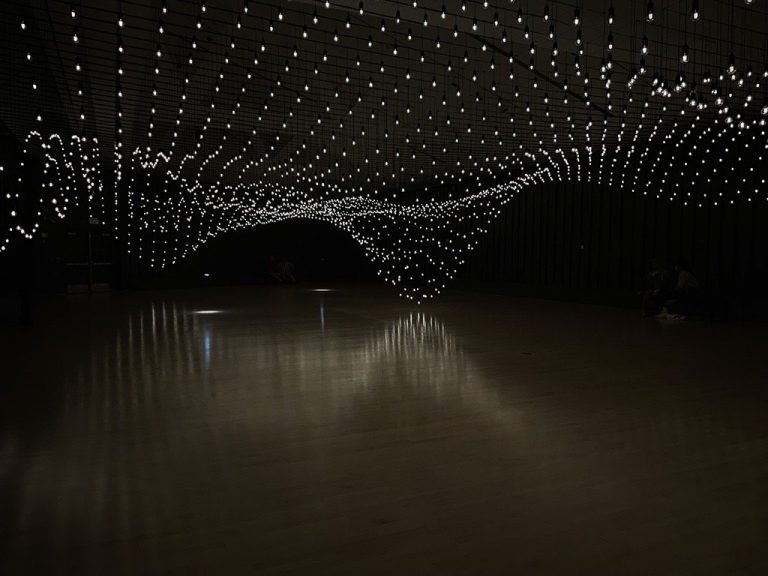Abby Shepherd
The Kemper Museum of Contemporary Art opened a free exhibition in late June, Pulse Topology, which will be available to the public until January. The exhibition is the newest installation from artist Rafael Lozano-Hemmer, who worked with the museum throughout the COVID-19 pandemic to create his project.
The exhibition is housed in a 5,000-square-foot space and is made up of 3,000 LED filament light bulbs strung up along the ceiling. Sensors hung from the ceiling use photoplethysmography (PPG) technology to detect a heartbeat. Visitors can place their hands underneath them. The rhythm is reflected by the lightbulbs surrounding the sensor, and this pattern grows throughout the rest of the room. The lightbulbs are strung in a pattern that emulates the Flint Hills and related topography.
Curator Erin Dziedzic said many challenges came along with planning Pulse Topology, mainly due to COVID-19. Lozano-Hemmer had to communicate and work with the museum virtually and saw the exhibition for the first time in person a few weeks ago.

Pulse Topology, June 25, 2021–January 2, 2022,
Charlotte Crosby Kemper Gallery, Kemper Museum of Contemporary Art.
“It wasn’t necessarily ideal, but I think we made the best of the situation,” Dziedzic said. “It was amazing to watch my team mobilize and come up with creative solutions and scenarios to move and shift exhibitions around. We ended up calling resources here in Kansas City, and we talked to people who have experience with these kinds of programs and technology.”
That kind of technology was also new to Lozano-Hemmer, as he planned to use the fingertip sensors that are found in doctors’ offices in order to detect heartbeats. Due to COVID-19, Lozano-Hemmer and the museum wanted to reduce the number of surfaces being touched, so they turned to PPG. PPG uses a light source and photodetector to read the heart rate at the surface of someone’s skin.
“There’s a small window in the back of the gallery that shows you the backroom with a series of computers, which do a couple of things,” Dziedzic said. “Once someone’s hand is read by the pulse function, you’ll see your heartbeat pretty prominently above your head, and it will start to expand into a sphere. Once that function goes through one rotation of your heartbeat, when you move your hand away, it’s then recorded and included into the rest of the 3,000 heartbeats forever.”
Working with the heartbeat is not new to Lozano-Hemmer, who started his Pulse series in 2006. He was inspired by the history of other artists working with the heart, and by his wife and children.
“When [Lozano-Hemmer’s] wife was pregnant with twins, he asked that he have two sonogram readers in the room at the same time so he could hear the heartbeats simultaneously, so that kind of, for him, coalesced his knowledge of artists working with the pulse and his personal experience,” Dziedzic said.
Dziedzic said she’s enjoyed watching visitors experience the exhibition with a sense of awe.
“It’s been such a wonderful example of how the meaning of a work changes and evolves,” Dziedzic said. “This piece was always poetic, it was always in relation to the heartbeat, our primary function in our body. This work gives light and prominence to something we can’t see on a daily basis.”
Pulse Topology will be at the Kemper Museum of Contemporary Art until Jan. 2, 2022. It is free to the public, and tickets for the museum can be reserved online here.

